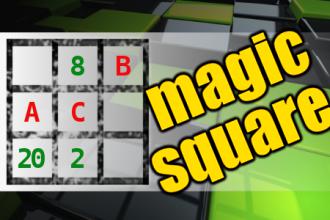MAGIC SQUARE: Calculate A-B+C
The aim is to place the some numbers from the list (2, 3, 5, 7, 8, 10, 18, 19, 20, 22, 57, 85, 87) into the empty squares and squares marked with A, B an C. Sum of each row and column should be equal. All the numbers of the magic square must be different. Find values for A, B, and C. Solution is A-B+C.Correct answers: 28
The first user who solved this task is Roxana zavari.
#brainteasers #math #magicsquare

Hunting With A Wife
A hunter visited another hunter and was given a tour of his home. Ibn the den was a stuffed lion. The visiting hunter asked, "when did you bag him?"
The host said, "that was three years ago, when I went hunting with my wife."
"What's he stuffed with," asked the visiting hunter.
"My wife."
The host said, "that was three years ago, when I went hunting with my wife."
"What's he stuffed with," asked the visiting hunter.
"My wife."

